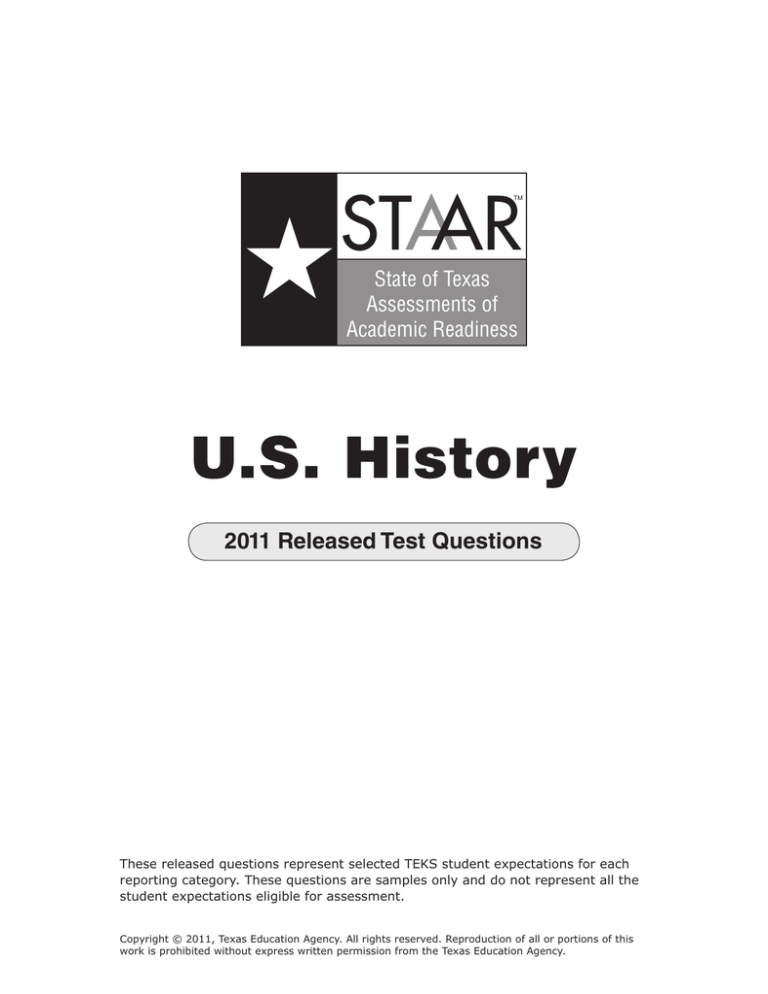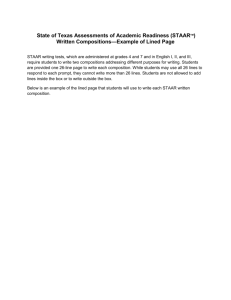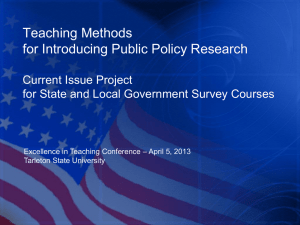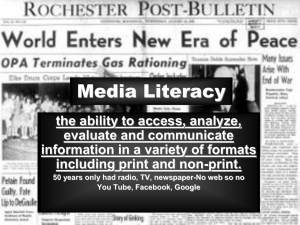Document 14083696
advertisement

STAAR TM State of Texas Assessments of Academic Readiness U.S. History 2011 Released Test Questions These released questions represent selected TEKS student expectations for each reporting category. These questions are samples only and do not represent all the student expectations eligible for assessment. Copyright © 2011, Texas Education Agency. All rights reserved. Reproduction of all or portions of this work is prohibited without express written permission from the Texas Education Agency. STAAR U.S. History 1 Released Test Questions 2011 Release After the attacks on September 11, 2001, how did U.S. foreign policy change? A The administration authorized preemptive strikes against nations sponsoring terrorism. B A program to reduce military bases and personnel in Europe was announced. C Military aid to Pakistan and Afghanistan was immediately cut off. D Diplomatic efforts to negotiate peace between Israel and Palestine were abandoned. 2 Questions Asked of Japanese Americans in 1943 No. 27. Are you willing to serve in the armed forces of the United States on combat duty, wherever ordered? No. 28. Will you swear unqualified allegiance to the United States of America and faithfully defend the United States from any or all attack by foreign or domestic forces, and foreswear any form of allegiance or obedience to the Japanese emperor, or any other foreign government, power, or organization? Japanese Americans were required to answer these questions before they were — A given a dishonorable discharge from the military B allowed to contest deportation orders to return to Japan C released from relocation centers D allowed to apply for repatriation to Japan Page 2 STAAR U.S. History 2011 Release Released Test Questions a Chin Ko This drawing illustrates the U.S. rationale behind — A entering agreements designed to prevent the use of nuclear weapons B establishing diplomatic relations with the People’s Republic of China C implementing a free-trade agreement with the government of North Korea D providing military aid to Ngo Dinh Diem’s government Page 3 Cambodia m na t Vie rea La o s 3 STAAR U.S. History 4 5 Released Test Questions 2011 Release Which set of events is listed in chronological order? A 1. 2. 3. 4. The United States declares war against Japan. President Richard Nixon resigns. The Supreme Court upholds segregation in Plessy v. Ferguson. Dwight D. Eisenhower is elected to a second presidential term. B 1. 2. 3. 4. The Supreme Court upholds segregation in Plessy v. Ferguson. The United States declares war against Japan. Dwight D. Eisenhower is elected to a second presidential term. President Richard Nixon resigns. C 1. 2. 3. 4. Dwight D. Eisenhower is elected to a second presidential term. The Supreme Court upholds segregation in Plessy v. Ferguson. President Richard Nixon resigns. The United States declares war against Japan. D 1. 2. 3. 4. President Richard Nixon resigns. The United States declares war against Japan. Dwight D. Eisenhower is elected to a second presidential term. The Supreme Court upholds segregation in Plessy v. Ferguson. During the early 1900s, Booker T. Washington supported a moderate strategy for attaining civil rights for African Americans, while W. E. B. Du Bois called for a more aggressive approach. During the 1960s, a similar difference emerged between — A Medgar Evers and Thurgood Marshall B Barbara Jordan and Alice Walker C Rosa Parks and Marcus Garvey D Martin Luther King, Jr., and Malcolm X Page 4 STAAR U.S. History 2011 Release Released Test Questions 6 Fred Hultstrand History in Pictures Collection, NDIRS-NDSU, Fargo House in Milton, North Dakota, 1898 Homesteaders on the Great Plains found it necessary to build the type of house shown in the photograph because — A the ground was not stable enough to support heavier structures B unpredictable weather conditions required settlers to build shelter rapidly C access to timber was limited by distance and lack of transportation D settlers lacked the skill required to build more-permanent structures Page 5 STAAR U.S. History 2011 Release Released Test Questions 7 Rural 1 Urban 2 3 4 Suburban Which arrow represents the heaviest volume of migration within the United States since 1960? A 1 B 2 C 3 D 4 Page 6 STAAR U.S. History 2011 Release Released Test Questions Image courtesy of Cleveland State University 8 This informational poster illustrates — A the resentment shown toward immigrants for taking U.S. jobs B a government effort to implement quotas on immigration C the movement to assimilate immigrants into U.S. culture D the requirement that immigrants become U.S. citizens Page 7 STAAR U.S. History 2011 Release Released Test Questions ©Eugene Elderman, Washington Post 9 Which of the following does this 1937 political cartoon satirize? A Congressional attempts to bypass the principle of separation of powers B President Franklin D. Roosevelt’s attempt to reorganize the Supreme Court C President Franklin D. Roosevelt’s refusal to cooperate with state governments D Congressional attempts to undermine the principle of state sovereignty Page 8 STAAR U.S. History Released Test Questions 2011 Release 10 How did incidents like the Gulf of Tonkin Resolution and the secret bombing of Cambodia eventually affect the relationship between the legislative and executive branches of government? A Presidents began to seek congressional approval of any military action. B Congress attempted to limit the president’s ability to act unilaterally. C The president relinquished to Congress the position of commander in chief. D Congress called for the impeachment of a president following military failures in Vietnam. 11 The Supreme Court’s 1964 decision in Reynolds v. Sims significantly affected U.S. politics by — A limiting the use of the legislative filibuster B regulating the amount of individual campaign contributions C requiring that state legislative districts be roughly equal in population D establishing term limits for elected government officials Page 9 STAAR U.S. History Released Test Questions 2011 Release 12 Which diagram shows how the completion of the transcontinental railroad contributed to the closing of the western frontier? A Improved communications Increased protection of sites sacred to American Indians B Greater ease of travel Higher demand for unclaimed territory C Advances in factory technology Improved agricultural processes D Faster shipping of raw materials More profits for timber companies 13 Parents faced a great fear—the dreaded poliomyelitis, or polio as it is commonly known. The disease had killed more than thirteen hundred Americans . . . and crippled more than eighteen thousand more in the year 1954 alone. On April 12, 1955, America received the much-welcomed news that Dr. Jonas Salk had . ? —“Frontiers in History,” National Archives and Records Administration, 2001 Which of the following completes this excerpt? A discovered a cure for infantile paralysis B founded a private hospital for children with polio C developed a vaccine against the frightening disease D identified the mode by which the disease was transmitted Page 10 STAAR U.S. History Released Test Questions 2011 Release 14 I hold that a corporation does ill if it seeks profit in restricting production . . . or seeking to achieve monopoly by illegal . . . treatment of its competitors. . . . If, on the other hand, a corporation seeks profit solely by . . . treating the public . . . and its rivals fairly: then such a corporation is behaving well. It is an instrumentality of civilization operating to promote abundance by cheapening the cost of living so as to improve conditions everywhere throughout the whole community. —Theodore Roosevelt: An Autobiography, 1913 The main strategy that President Roosevelt’s administration used to stop the type of business practices criticized in this excerpt was to — A establish the Federal Reserve System to regulate the money supply B urge the Interstate Commerce Commission to decrease corporate regulations C use the Sherman Antitrust Act to ensure competition in industry D lobby Congress to loosen restrictions on foreign exports Page 11 STAAR U.S. History 2011 Release Answer Key Item Number Reporting Category Readiness or Supporting Content Student Expectation Process Student Expectation 1 1 Readiness H.11(A) 2 1 Readiness H.7(D) H.29(B) C 3 1 Readiness H.8(D) H.29(H) D 4 1 Supporting H.2(C) H.29(B) B 5 1 Supporting H.9(D) 6 2 Readiness H.12(A) H.29(H) C 7 2 Readiness H.13(A) H.29(H) D 8 2 Supporting H.26(B) H.29(H) C 9 3 Readiness H.20(B) H.29(H) B 10 3 Supporting H.20(A) B 11 3 Readiness H.21(A) C 12 4 Supporting H.15(A) H.29(B) B 13 4 Supporting H.27(B) H.29(B) C 14 4 Readiness H.15(B) H.29(B) C A D For more information about the new STAAR assessments, go to www.tea.state.tx.us/student.assessment/staar/. Page 12 Correct Answer




